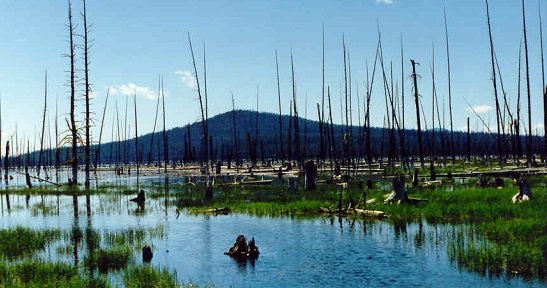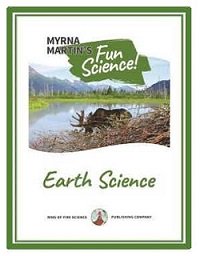Large & Small Shield Volcanoes
Shield volcanoes form over hot spots
Magma from the upper mantle
Shield volcanoes form over hot spots in oceans. The magma that forms these volcanoes comes from the upper mantle. The Hawaiian Islands have formed over a hot spot in the middle of the Pacific Ocean. The Pacific Ocean has drifted over this hot spot creating a string of volcanic islands and seamounts that stretch all the way to the North Pacific Ocean.

Small shield volcano in the Cascade Mountains of Oregon
Hawaiian volcanoes
Hawaiian Island volcanoes
The Hawaiian Islands are large shield volcanoes that dwarf continental volcanoes. Mauna Loa, on the island of Hawaii, is 375 times larger than Mount Hood in Oregon. These volcanoes characteristically have a broad summit with a caldera formed by collapse.
Formation of calderas
Flank eruptions produce calderas when magma drains out of shallow chambers beneath the summit of a shield volcano. Craters and pit craters are smaller than calderas and form when the summit collapses.
Rift zones
Rift zones radiate from the summit
Rift zones radiate from summit calderas extending down the flanks of the volcanoes. Rift zones are long ridges with open fissures, pit craters, cinder cones, and small shields.
Rift zones 120 degrees apart
These zones are weaknesses in the volcano that allow molten rock to flow down the volcano's side and enlarge it. There are usually three rift zones on shield volcanoes 120 degrees apart.


Click for More Information or to Order
basalt lava from the upper mantle
Basalt lava
Shields are formed by layers of fluid basalt lava. Basalt lava which originated in the mantle contains ferromagnesian minerals. These minerals are magnesium and iron rich. Basalt lava flows form more than 99% of an Hawaiian Island volcano's mass above sea level.
Pahoehoe lava
Native Hawaiians first used the terms pahoehoe and aa to describe basalt lava flows on their islands. Pahoehoe flows are characterized by smooth, billowy or ropy surfaces. Many pahoehoe flows form lava tubes which help transport lava down the slope of a volcano before it cools.
Aa lava
Aa lava forms a rough surface that is difficult to walk across because of its sharp edges. Aa lava has the same composition as pahoehoe flows but is cooler and does not flow as fast as pahoehoe flows. Pahoehoe flows that cool on a volcano's flank can become an aa flow.
KIDS FUN Science Bookstore
Check out Myrna Martin's award winning textbooks, e-books, videos and rock sets. The Kids Fun Science Bookstore covers a wide range of earth science topics. Click here to browse.










